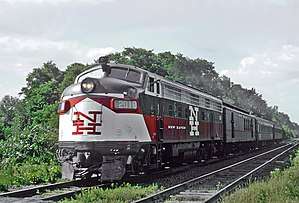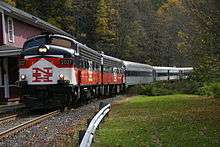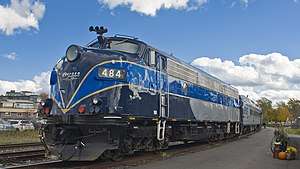EMD FL9
The EMD FL9 (New Haven Class EDER-5) is a dual-power electro-diesel locomotive, capable of diesel-electric operation and as an electric locomotive powered from a third rail. Sixty units were built between October 1956 and November 1960 by General Motors Electro-Motive Division for the New York, New Haven and Hartford Railroad (the "New Haven").
| EMD FL9 | |||||||||||||||||||||||||||||||||||||||
|---|---|---|---|---|---|---|---|---|---|---|---|---|---|---|---|---|---|---|---|---|---|---|---|---|---|---|---|---|---|---|---|---|---|---|---|---|---|---|---|
 New Haven FL9 No. 2010 at Enfield in 1968 | |||||||||||||||||||||||||||||||||||||||
| |||||||||||||||||||||||||||||||||||||||
| |||||||||||||||||||||||||||||||||||||||
| |||||||||||||||||||||||||||||||||||||||
| |||||||||||||||||||||||||||||||||||||||
Design
The locomotive was based on the EMD FP9, lengthened to accommodate additional equipment, including a larger train heating steam boiler. Due to the additional weight, the locomotive was equipped with a three-axle rear truck, giving it an uncommon B-A1A wheel arrangement. The middle axle of the rear truck was not powered. The Flexicoil type of truck was used at both front and rear, due to this type of truck having more room for fitting the third rail shoes.[1]
The FL9 was capable of using either an over-running or under-running third rail by means of retractable shoes operated by pneumatic cylinders. The first thirty locomotives had a small DC pantograph for use within New York City's Grand Central Terminal, where long gaps exist in the third rail because of the complex trackage that includes numerous railroad switches.[2] For operation into the Pennsylvania Railroad's Pennsylvania Station, the FL9 used the Long Island Rail Road's third rail system.[3]
The electrical supply available from the third rail—660 V DC—was identical to the requirements of diesel locomotive traction motors, enabling a fairly easy conversion to a dual-power locomotive. A DC electric compressor provided air for the brake system until the diesel engine was started. Two batches of FL9s were built; 30 locomotives (including the original test units 2000 and 2001, originally built with a Blomberg front truck, but later upgraded following testing) from October 1956 through November 1957 of 1,750 hp (1,305 kW) from an EMD 567C engine; and 30 between June and November 1960 of 1,800 hp (1,342 kW) from a newer EMD 567D1 engine.[4] The two engines for the unit were 16 cylinders designated as the 567C with 1750 horsepower and the 567D1 with 1800 horsepower.[5] The paint scheme as delivered was the bright McGinnis scheme of red-orange, black and white and the Herbert Matter designed "NH" logo. FL9s were initially fitted with the Hancock air whistle, a trademark of New Haven units of this time, instead of the standard air horns on diesel locomotives.
Operation
New Haven trackage between Woodlawn and New Haven, Connecticut, 72 miles from Grand Central, was electrified in the early 1900s at 11,000 volts, 25 Hz AC overhead. The New Haven was the pioneer of heavy mainline railroad electrification in the United States. Early plans to extend the catenary to Boston were never completed due to the perennial financial problems that plagued the New Haven almost continuously from the 1920s to its demise in 1969. Amtrak finished the project in 1999 in advance of the Acela Express.
The FL9s allowed through passenger trains from Grand Central Terminal to reach Boston, Springfield, and other non-electrified destinations without the need for an engine change at New Haven. They were purchased with the intent of allowing the eventual elimination of all New Haven electric locomotives and the abandonment of the electrification east of Stamford, Connecticut, 33 miles from Grand Central. The fact that the entire New York to Boston line is now electrified shows the short-sightedness of this concept, which had been adopted by the McGinnis management to avoid the cost of modernizing the New Haven's Cos Cob, Connecticut power plant. The New Haven to Boston electrification was completed by Amtrak in 1999.
Prior to the introduction of the FL9, all non-multiple unit New Haven passenger trains were hauled by electric locomotives between New York and New Haven, with a change to steam (before 1950) or diesel at New Haven. Meeting the weight limits of the Park Avenue Viaduct in Manhattan, the FL9 made it possible to eliminate the engine change. FL9s were used on the New Haven's premier name train, the Merchants Limited, which covered the 229.5 miles between Grand Central Terminal and South Station, Boston in 4 hours 15 minutes.
Introduction of the FL9 allowed the New Haven to scrap its entire fleet of pre-1955 electric locomotives, many of which were less than 25 years old. The FL9 had higher operating costs and lower performance than the electric locomotives it replaced. The only New Haven electrics surviving through the FL9 period were the General Electric EP5 "Jets" of 1955 as well as the freight service General Electric E33s purchased secondhand from the Virginian Railroad in 1959. Three FL9s were required to approach the performance of one EP5. But the powerful "Jets" were doomed by poor maintenance, and the last were retired in 1977, after having been regeared for freight service by inheritor Penn Central in 1973. In keeping with the New Haven's policy of dual service utilization of locomotives, FL9s were used at night to move a Trailer-on-FlatCar (TOFC) train, with difficulty, in one direction between the Cedar Hill yard in New Haven and the Oak Point yard in The Bronx. Assigned to this train in the other direction, an EP5 locomotive could easily outrun automobile traffic on the adjacent Connecticut Turnpike.

Despite being under-powered compared to the powerful electrics they replaced, which also had their problems. However, for other reasons, the New Haven never did abandon its electrification, negating the primary reason for purchasing the FL9s.
In 1969, the New Haven FL9 fleet passed to Penn Central on the merger of the Pennsylvania Railroad and New York Central Railroad, and some were repainted in Penn Central schemes, while others remained in their former New Haven paint. When the New York Metropolitan Transportation Authority (MTA) began funding these commuter services in 1970, many were repainted blue with a bright yellow nose, although they remained Penn Central-owned. The locomotives passed to Conrail in 1976. Twelve FL9s were sold to Amtrak, six of which were remanufactured by Morrison-Knudsen starting in 1978 and remained in Amtrak service until at least 1996.[6][7]
In 1983, Conrail passed its commuter operations to state agencies. In New York State, the MTA formed Metro-North Railroad as a subsidiary company to operate these, and operations in Connecticut under contract with that state. The locomotives were repainted in Metro-North colors (more commonly in a silver, blue, and red scheme;[8] some in a silver and blue scheme[9]), and a large number of them, now in some cases over 25 years old, were rebuilt and modernized. Ten rebuilt for the Connecticut Department of Transportation (CDT) were painted in the original New Haven (New York, New Haven and Hartford Railroad) paint scheme, which has since been applied to remanufactured locomotives in the CDT's Shoreline East service pool, as well as on four new GE Genesis II P32AC-DM dual-mode locomotives and six Brookville BL20GH Diesel-electric locomotives.
Many were replaced only in the early years of the 21st century by new power, a service life of almost 50 years. Despite this, the FL9s were restricted to branch lines near the end of their lives since they no longer had the ability to operate on third rail power. Metro-North and Connecticut DOT, along with the Housatonic Railroad, operated a "Farewell to the FL9's" fan trip from Stamford, CT to Canaan, CT and return on October 23, 2005. The last FL9 to see passenger service was in late 2009; Metro-North retired all its remaining FL9s in 2009. The FL9s owned by the Connecticut Department of Transportation were also retired by 2009; six were sold to other operators or museums by the end of 2018.[10][11]
Original owners
| Railroad | Quantity | Road numbers |
|---|---|---|
| New York, New Haven and Hartford Railroad | ||
Surviving examples

Several FL9s exist today, donated to several museums and railways.
- All Amtrak units were purchased by the Morristown and Erie Railway, New Jersey, but many were scrapped or cannibalized for parts.
- 488-489 are in service at the Whippany Railway Museum, where they can be seen pulling excursions run by the museum. 488-489 originally pulled excursions on the M&E owned Maine Eastern Railroad until the railroad ceased operations.
- 484 is now in operation at the Orford Express in eastern Quebec, Canada, having been previously owned by the Cuyahoga Valley Scenic Railroad.
- 2023 (formerly New Haven #2057) is preserved at the Connecticut Eastern Railroad Museum.[12]
- All remaining ConnDOT-owned units (2011, 2014, 2016, 2019, 2024, 2026, 2027) were sold to private owners by 2018, as following:
- 2011 & 2026 are in service and maintained on the Massachusetts Coastal Railroad/Cape Cod Central Railroad in Massachusetts.
- 2014 & 2016 are in ownership of the Grapevine Vintage Railroad as of October 2019. 2016 began running in service running scenic rail service between Grapevine, Texas and The Fort Worth Stock Yards.
- 2019 (formerly New Haven #2049) is in ownership of the Railroad Museum of New England. It was in operation at the Streamliners at Spencer event in North Carolina from May 29, 2014 to June 1, 2014. It is now used to pull RMNE's Northern Lights Limited holiday train on the Naugatuck Railroad during the winter season.[13]
- 2024 is in ownership of the Berkshire Scenic Railway Museum.
- The Railroad Museum of New England currently has two FL9s awaiting restoration: the oldest surviving FL9, New Haven No. 2005 (currently numbered as No. 2002)[13] as well as the very last EMD F-unit ever built, New Haven No. 2059 (current painted in Metro-North livery as Metro-North No. 2033).[14]
- Two FL9s, No. 2006 and No. 2013, are preserved at the Danbury Railway Museum. No. 2006 wears the New Haven Livery, while 2013 wears New York Central livery, despite the NYC never owning any FL9s.[15]
In popular culture
In 1978, FL9 #5048 was used in the filming of the original Superman movie starring Christopher Reeve. Still painted in New Haven livery, the unit was depicted pulling a commuter train past the entrance to Lex Luthor's hideout during the villain's introduction scene.[16]
Notes
- Solomon 2011, p. 114
- Hartley 1993, p. 35
- Hartley 1993, p. 36
- Pinkepank 1973, p. 101
- Garrat, Colin (1999). The World Encyclopedia of Locomotives. USA: Anness. p. 156. ISBN 1-84038-487-5.
- "AMTRAK E8's, late 1970s... Bonus, AMTRAK FL9's, 1996" – via www.youtube.com.
- "Amtrak FL-9 @ Yonkers.(1996)" – via www.youtube.com.
- White, Eric. "Rapido Trains HO scale FL9 diesel locomotive". Model Railroader (February 2016). Retrieved 1 November 2016.
- "New model trains for the week of March 3, 2015". Model Railroader. 2 March 2016. Retrieved 1 November 2016.
- Kadden, Jack (2005-11-06). "The Last Stop Draws Near: Catching Up With the FL9". New York Times. Retrieved 2013-04-30.
- https://trn.trains.com/news/news-wire/2018/10/03-connecticut-sells-its-last-fl9-locomotives
- EMD FL9 Connecticut Eastern Railroad Museum
- otto.vondrak. "CDOT 2002 (NH 2005) and 2019 (NH 2049) – Railroad Museum of New England". Retrieved 2019-01-06.
- otto.vondrak. "New Haven 2059 (Metro-North 2033) – Railroad Museum of New England". Retrieved 2019-01-06.
- http://www.danburyrailwaymuseum.org/roster.htm
- ""Superman" (1978) Goofs". IMDB.com. Retrieved June 5, 2015.
References
| Wikimedia Commons has media related to EMD FL9 locomotives. |
- Hartley, Scott (March 1993). "The Unsinkable FL9". Trains. Vol. 53 no. 3. pp. 34–41. ISSN 0041-0934.CS1 maint: ref=harv (link)
- Pinkepank, Jerry A. (1973). The Second Diesel Spotter's Guide. Milwaukee, Wisconsin: Kalmbach Publishing. ISBN 978-0-89024-026-7.CS1 maint: ref=harv (link)
- Solomon, Brian (2011). Electro-Motive E-Units and F-Units: The Illustrated History of North America's Favorite Locomotives. Minneapolis, Minnesota: Voyageur Press. ISBN 978-0-7603-4007-3.CS1 maint: ref=harv (link)
Further reading
- Cook, Preston (July 2008). "Something About F-Units". Railfan & Railroad. Vol. 27 no. 7. pp. 42–49. ISSN 0163-7266.CS1 maint: ref=harv (link)
- Hollingsworth, Brian; Cook, Arthur F. (1987). The Great Book of Trains. New York: Portland House. ISBN 978-0-517-64515-4.
- Lamb, J. Parker (2007). Evolution of the American Diesel Locomotive. Railroads Past and Present. Bloomington, Indiana: Indiana University Press. ISBN 978-0-253-34863-0.
- Marre, Louis A. (1995). Diesel Locomotives: The First 50 Years: A Guide to Diesels Built Before 1972. Railroad Reference Series. Waukesha, Wisconsin: Kalmbach Publishing. ISBN 978-0-89024-258-2.
- Middleton, William D. (2001) [1974]. When the Steam Railroads Electrified (2nd ed.). Bloomington, Indiana: Indiana University Press. ISBN 978-0-253-33979-9.CS1 maint: ref=harv (link)
- Schafer, Mike (1998). Vintage Diesel Locomotives. Enthusiast Color Series. Osceola, Wisconsin: MBI Publishing. ISBN 978-0-7603-0507-2.CS1 maint: ref=harv (link)
- Solomon, Brian (2000). The American Diesel Locomotive. Osceola, Wisconsin: MBI Publishing Company. ISBN 978-0-7603-0666-6.CS1 maint: ref=harv (link)
- Solomon, Brian (2005). EMD F-Unit Locomotives. North Branch, Minnesota: Specialty Press. ISBN 978-1-58007-192-5.CS1 maint: ref=harv (link)
- Solomon, Brian (2006). EMD Locomotives. St. Paul, Minnesota: Voyageur Press. ISBN 978-0-7603-2396-0.CS1 maint: ref=harv (link)
- Solomon, Brian (2010). Vintage Diesel Power. Minneapolis, Minnesota: MBI Publishing. ISBN 978-0-7603-3795-0.CS1 maint: ref=harv (link)
- Solomon, Brian (2012). North American Locomotives: A Railroad-by-Railroad Photohistory. Minneapolis, Minnesota: Voyageur Press. ISBN 978-0-7603-4370-8.CS1 maint: ref=harv (link)
- Swanberg, J. W. (Spring 2015). "Playing With Fire: The Saga of the FL9". Classic Trains. Vol. 16 no. 1. pp. 78–83. ISSN 1527-0718.CS1 maint: ref=harv (link)
- Wilson, Jeff (1999). F Units: The Diesels That Did It. Golden Years of Railroading. Waukesha, Wisconsin: Kalmbach Publishing. ISBN 978-0-89024-374-9.